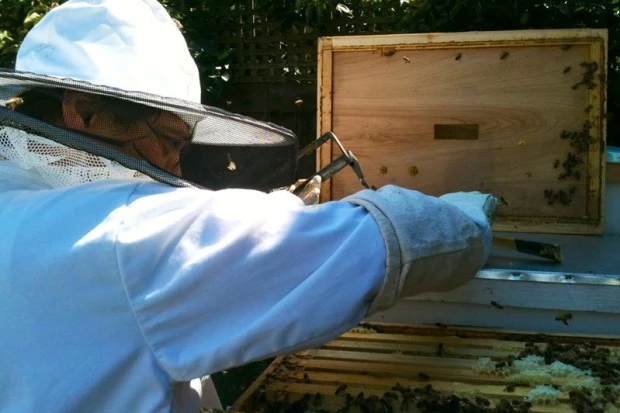Hives Not Collapsing
I got this missive from my friend Rachel McConnell. If you are interested in the story and worries about beehives collapsing, read his story!
Some of you have met my boyfriend Gerard and some of you have gotten
honey from him in the past. He has just launched an ambitious campaign
to improve bee genetic diversity in the Bay Area through seeding and
swapping hives – well, I had better let him tell you about it:https://www.indiegogo.com/projects/urban-bee-genetic-diversity-project/x/3910178#/
Kick in a couple bucks???
I’m going to include his Indigogo post here for beautiful posterity.
Hello my name is Gerard and I’m an urban beekeeper.
About seven years ago I was living in the Niles neighborhood in Fremont. I decided to raise bees with the intention of improving the viability of my vegetable garden as well as increase the yield of an avocado tree on the property that wasn’t doing to well.
That year was fabulous. The avocado tree bore lots of fruit. The heirloom tomatoes, squash, melons, cucumbers, rainbow chard.everything in the entire garden was exploding with abundance. I couldn’t believe that such a small plot could produce so much food. The yields were so high that I resorted to knocking on doors around the neighborhood giving food away.
That one hive became two, then three, I was unabashedly splitting hives, and mixing them up, putting bees from one hive into another, and another. Soon I had installed numerous colonies between the cities of Fremont, Oakland, Alameda, Richmond, and the Sierra foothills. I even taught the scary looking old timers that belonged to a “motorcycle club” how to raise bees. Those bees eventually made it as far as Seattle Washington.
My approach was also an organic one. In contrast to my methods, The commercial beekeeping industry were losing colonies to collapse. In an effort to protect their livelihood they used interventions that I considered desperate measures. There were was an insecticide for controlling Varroa mites, antibiotics for a fungus called nosema, terramycin for foulbrood, and paradich-lorobenzene, a known carcinogen for wax moths, They were even putting things in the hive called oxalic acid. if you look on the labels of many of these things they will say toxic to humans! Some members of the local beekeeping club began to eventually use these methods. I was as if the pharmaceutical companies were coming around to sell you the latest antibiotic.
I ignored all these suggestions and carried on with my organic methods and continued to split my hives, experimenting and moving bees from one city to another, and across county lines. While colonies were collapsing all around me. I found that I had almost a 100% survival rate. Why? Hybrid vigor. The genetic diversity of my bees became a key to their survival. I was splitting hives, and mixing them up across county lines. My queens could be in Fremont one month, and in Alameda the next. This gave her the opportunity to mate with the drones where she happened to be at that moment, inevitably increasing the diversity and strength of the Hive. Recently researchers have found that queens that have mated at least seven times are almost three times more likely to survive.
These tough bees had developed resistance. The same resistance that they have had for thousands of years before humans came along. I have found by accident why my hives don’t collapse. I used a strictly organic method coupled with a limited amount of meddling, and a rationed approach to honey harvest. I leave the majority of the honey for the bees so that they can make it through the winter. Only then in the spring when the nectar flows begin will I take honey from the previous year.
https://www.sciencedaily.com/releases/2013/06/1…
We’ve had a great winter here in California and the wildflower blooms are going to be spectacular. I predict that the nectar flows will also be amazing. If theres any year in the history of California that will be conducive to the to the honeybee ecology. 2016 would be it.
Bees are dying from a number of factors, but what we can do we should do. and this includes raising genetically tough bees.
I would love to raise genetically tough bees and install these hives throughout every corner of the bay area, but I need your help to do it.
Each hive costs about $400 to set up. I would be happy to take care of them, and teach others how to take care of them also. Its fun, and it helps save the bees. the plan is to build as many hives as we can fund, and space them throughout the bay area. Ive set the funding goal to $8,000 so that we can add 20 hives to the area. Every $400 we go over, Ill install another hive. The more money raised, the more hives we install thus improving the genetic diversity of the bay area bee.
